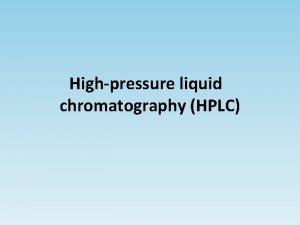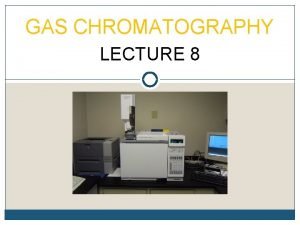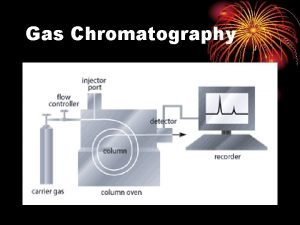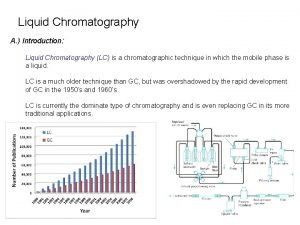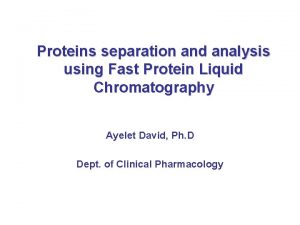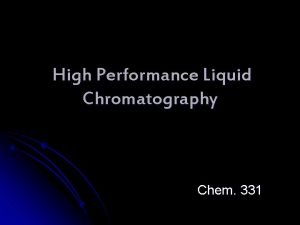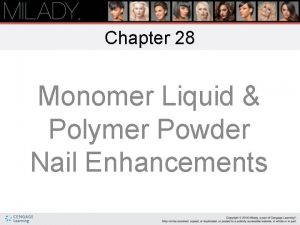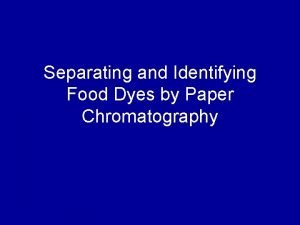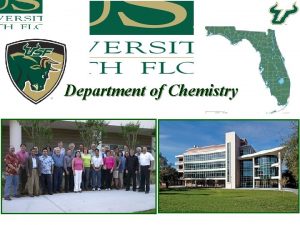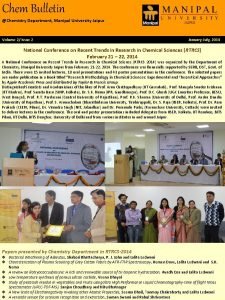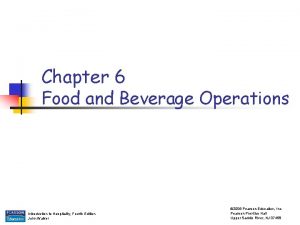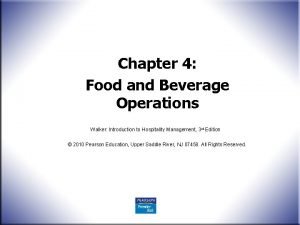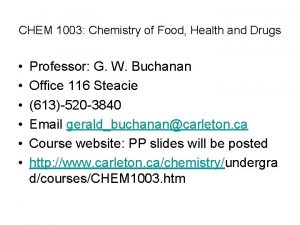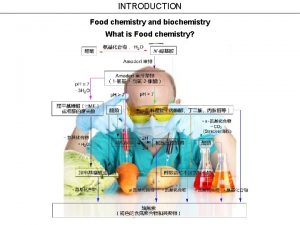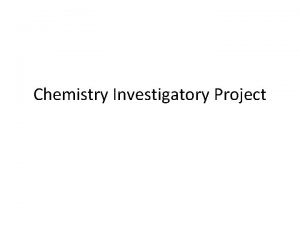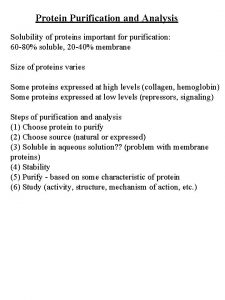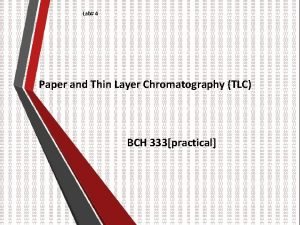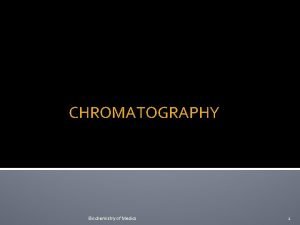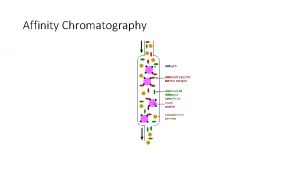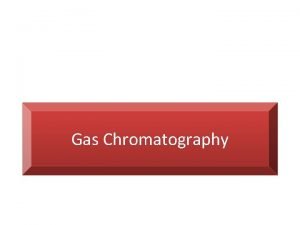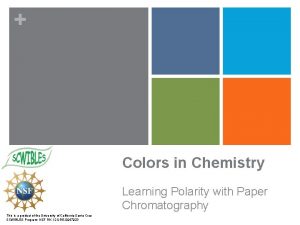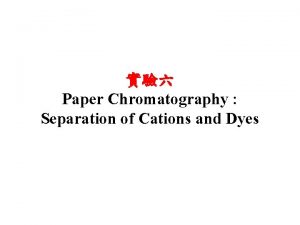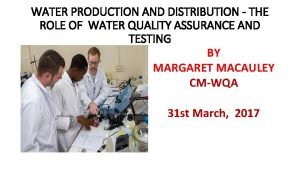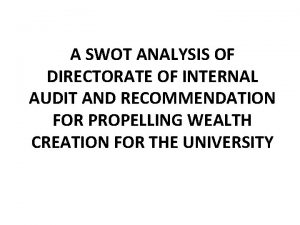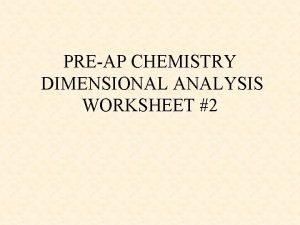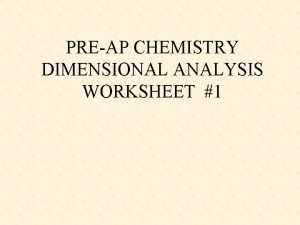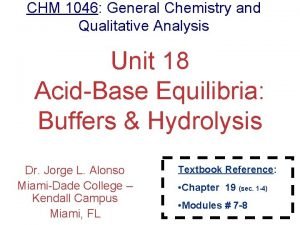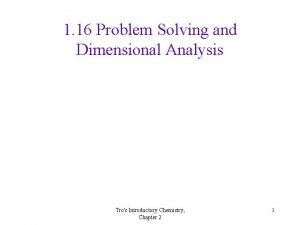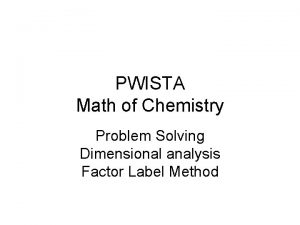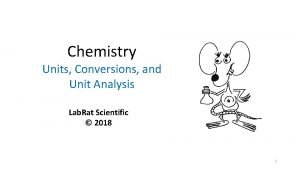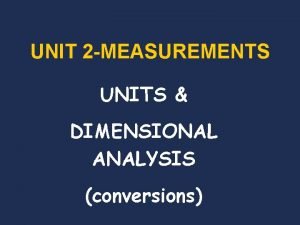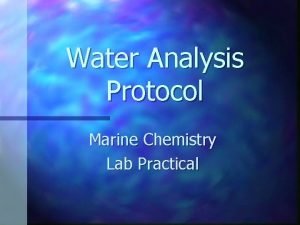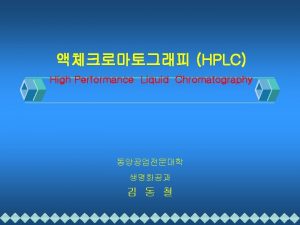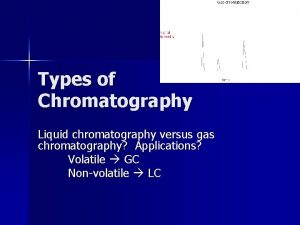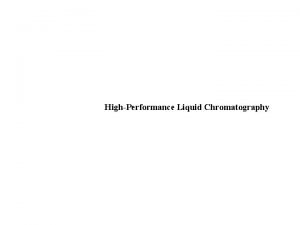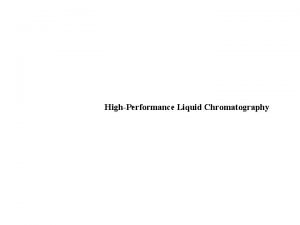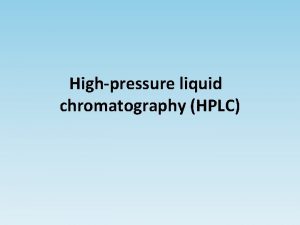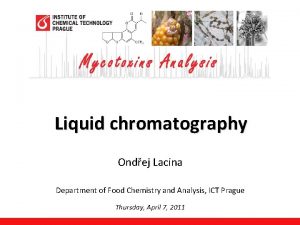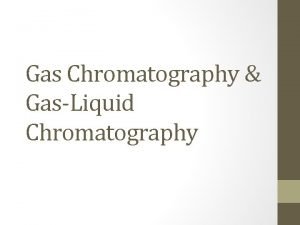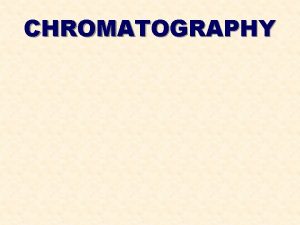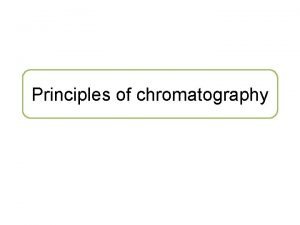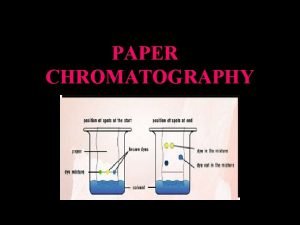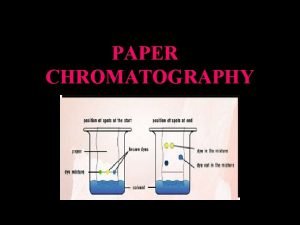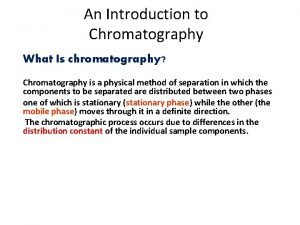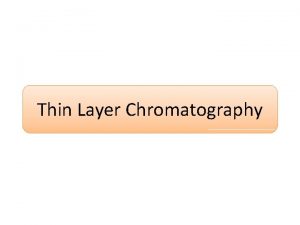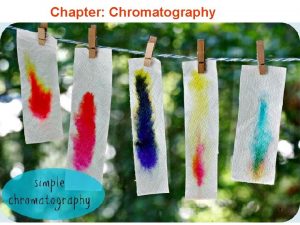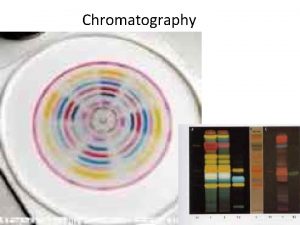Liquid chromatography Department of Food Chemistry and Analysis



































































































- Slides: 99

Liquid chromatography Department of Food Chemistry and Analysis, ICT Prague

What is chromatography? § Derived from the Greek word Chroma meaning colour, chromatography provides a way to identify unknown compounds and separate mixtures.

Introduction to Chromatography Definition: § Chromatography is a separation technique based on the different interactions of compounds with two phases, a mobile phase and a stationary phase, as the compounds travel through a supporting medium. § Components: • Mobile phase: a solvent that flows through the supporting medium. • Stationary phase: a layer or coating on the supporting medium that interacts with the analytes. • Supporting medium: a solid surface on which the stationary phase is bound or coated.

Milestones in Chromatography § 1903 Tswett - plant pigments separated on § § § chalk columns 1931 Lederer & Kuhn - LC of carotenoids 1938 TLC and ion exchange 1950 reverse phase LC 1954 Martin & Synge (Nobel Prize) 1959 Gel permeation 1965 instrumental LC (Waters) Milestones in Chromatography

Types of Chromatography Paper (PC) Thin Layer (TLC) Gas (GC) Chromatography Liquid (LC) Supercritical Fluid (SFC)

Types of Chromatography

Chromatographic methods classification Geometry of the system: § Column chromatography: the stationary phase (solid particles) is in a tube called the column. § Planar chromatography: In this geometry the stationary phase is configured as a thin two-dimensional sheet. • In paper chromatography a sheet or a narrow strip of paper serves as the stationary phase. • In thin-layer chromatography a thin film of a stationary phase of solid particles bound together for mechanical strength with a binder, such as calcium sulfate, is coated on a glass plate or plastic or metal sheet.

Chromatographic methods classification Mode of operation Development chromatography § In terms of operation, in development chromatography the mobile phase flow is stopped before solutes reach the end of the bed of stationary phase. The mobile phase is called the developer, and the movement of the liquid along the bed is referred to as development. Example of planar development chromatography – TLC or PC Elution chromatography. § This method, employed with columns, involves solute migration through the entire system and solute detection as it emerges from the column. The detector continuously monitors the amount of solute in the emerging mobile-phase stream—the eluate—and transduces the signal, most often to a voltage, which is registered as a peak on a strip-chart recorder.

Chromatographic methods classification Phases involved (mobile phase) § The primary division of chromatographic techniques is based on the type of mobile phase used in the system: Type of Chromatography Type of Mobile Phase • Gas chromatography (GC) gas • Liquid chromatography (LC) liquid

Chromatographic methods classification Phases involved (stationary phase) Further divisions can be made based on the type of stationary phase used in the system: Gas Chromatography: Name of GC Method: Type of Stationary Phase Gas-solid chromatography Solid, underivatized support Gas-liquid chromatography Liquid-coated support Bonded-phase gas chromatography Chemically-derivatized support

Chromatographic methods classification Phases involved (stationary phase) Further divisions can be made based on the type of stationary phase used in the system: Liquid Chromatography: Name of LC Method: Type of Stationary Phase Adsorption chromatography Solid, underivatized support Partition chromatography Liquid-coated or derivatized support Ion-exchange chromatography Support containing fixed charges Size exclusion chromatography Porous support Affinity chromatography Support with immobilized ligand

Chromatographic methods classification Retention mechanism § Classification in terms of the retention mechanism is approximate, because the retention actually is a mixture of mechanisms. The main types of molecular interactive force are: • Van der Wall interactions (hydrophobic) • Polar (dipole-dipole: hydrogen bonding, π-π interactions) • Ionic • Special (affinity, chiral)

LC Separation Main type of interactions in liquid chromatography Dipole interaction Van der Wall interaction (hydrophobic) Hydrogen bond π-π interactions Electrostatic interaction (ionic)

Principle of separation Adsorption chromatography § Chromatography in which separation is based mainly on differences between the adsorption affinities of the sample components for the surface of an active solid. § Usually used anorganic sorbents Al 2 O 3, Si. O 2 etc. § Traditional adsorption chromatography is a „normal phase“ chromatography.

Principle of separation Partition chromatography § Chromatography in which separation is based mainly on differences between the solubility of the sample components in the stationary phase (gas chromatography), or on different solubilities of the component between mobile and stationary phases (liquid chromatography). § Modified anorganic support § In LC could be both normal (polar stationary phase) and reversed (nonpolar stationary phase).

Principle of separation Ion-exchange chromatography § Chromatography in which separation is based mainly on differences in the ion-exchange affinities of the sample components. Anions like SO 3 - or cations like N(CH 3)3+ are covalently attached to stationary phase, usually a resin,

Principle of separation Molecular exclusion chromatography § A separation technique in which separation mainly according to the hydrodynamic volume of the molecules or particles takes place in a porous non-adsorbing material with pores of approximately the same size as the effective dimensions in solution of the molecules to be separated.

Principle of separation Affinity chromatography § The particular variant of chromatography in which the unique biological specificity of the analyte and ligand interaction is utilized for the separation.

Theory of Chromatography § Typical response obtained by chromatography (i. e. , a chromatogram): chromatogram - concentration versus elution time. signal t. R(2) t. R(1) Component 2 Component 1 W(h) t 0 W(b) t‘R(1) Sample injection (t = 0) t 0 t. R t‘R W(b) W(h) t‘R(2) time (t) Void time = retention time of compound without retention Retention time Net retention time(t‘R - t 0) Base peak width Half-of-height peak width

Theory of Chromatography § A similar plot can be made in terms of elution volume instead of elution time. signal VR(2) VR(1) Elution volume (ml) Component 2 Component 1 W(h) V 0 Elution time (min) W(b) V‘R(1) Sample injection (V = 0) V 0 VR V‘R W(b) W(h) V‘R(2) Volume (V) Void volume = eltuion volume of compound without retention Retention volume Net retention volume (V‘R - V 0) Base peak width Half-of-height peak width Flow rate of mobile phase (ml/min)

Theory of Chromatography Capacity factor (k‘): § More universal measure of retention, determined from t. R or VR. § Capacity factor is useful for comparing results obtained on different systems since it is independent on column length and flow-rate.

Theory of Chromatography Capacity factor (k‘): § The value of the capacity factor is useful in understanding the retention mechanisms for a solute, since the fundamental definition of k’ is: k’ is directly related to the strength of the interaction between a solute with the stationary and mobile phases § Moles Astationary and moles Amobile phase represents the amount of solute present in each phase at equilibrium. Equilibrium is achieved or approached at the center of a chromatographic peak. k‘ ≈ 1. 0, separation is poor k‘ > 30, separation is slow k‘ = 2 -10, separation is optimum

Theory of Chromatography Efficiency of chromatography § Efficiency is related experimentally to a solute’s peak width. • An efficient system will produce narrow peaks • Narrow peaks ≈ smaller difference in interactions in order to separate two solutes § Efficiency is related theoretically to the various kinetic processes that are involved in solute retention and transport in the column • Determine the width or standard deviation (σ) of peaks Estimate (σ) from peak widths, assuming Gaussian shaped peak: Wb = 4σ Wh = 2. 354σ

Theory of Chromatography Number of theoretical plates (N): § Compare efficiencies of a system for solutes that have different retention times: § Gaussian shaped peak: The larger the value of N is for a column, the better the column will be able to separate two compounds: § The better the ability to resolve solutes that have small differences in retention. § N is independent of solute retention § N is dependent on the length of the column

Theory of Chromatography Plate height or height equivalent of a theoretical plate (H or HETP): § Compare efficiencies of columns with different lengths: L = column length N = number of theoretical plates for the column Note: H simply gives the length of the column that corresponds to one theoretical plate. § H can be also used to relate various chromatographic parameters (e. g. , flow rate, particle size, etc. ) to the kinetic processes that give rise to peak broadening.

Theory of Chromatography Why Do Bands Spread? 1. Eddy diffusion – different molecules have to travel different distance 2. Longitudinal diffusion – molecules move from the place with higher concentration to place with lower concentration 3. Stationary phase mass transfer – different depth of molecules diffusion into the stationary phase particle. 4. Mobile phase mass transfer – diffusion asociated with different mobile phase velocity

Theory of Chromatography Rate Theory of Chromatography § The HEPT height depends on mobile phase velocity (u): H = HL + HS + HM + HSM H HL HS HM HSM Plate equivalent to theoretical plate (as in Plate Theory) Contribution to the longitudinal diffusion Stationary phase mass transfer contribution Diffusion associated with mobile phase effect Diffusion into or mass transfer across a stagnant layer of mobile phase Van Deemter equation

Theory of Chromatography

Theory of Chromatography Separation factor § Universal measure of retention, determined from t. R or VR: k‘(1) – capacity factor of solute 1 k‘(2) – capacity factor of solute 2, when k‘(2) > k‘(1) § A value of α > 1. 1 is usually indicative of a good separation Does not consider the effect of column efficiency or peak widths, only retention. signal t. R(2) t. R(1) Component 2 Component 1 t 0 time (t)

Theory of Chromatography Resolution (RS): § Resolution between two peaks is a second measure of how well two peaks are separated: tr 1, Wb 1 retention time and baseline width for the first eluting peak tr 2, Wb 2 retention time and baseline width for the second eluting peak signal t. R(2) t. R(1) Component 2 RS is preferred over α since both retention (tr) and column efficiency (Wb) are considered in defining peak separation. Component 1 t 0 Wb(1) Wb(2) time (t)

Theory of Chromatography Factors affecting resolution § Selectivity expressed as Separation factor (α) § Retention of later eluted compound expressed as Capacity factor (k‘) § Efficiency expressed as number of effective plates (N) Selectivity term § Type of stationary phase § Used mobile phase § Solubility of analysed compounds in mobile phase Retention term Efficiency term § Elution strenght § Column lenght § Type and amount of stationary § Particle size phase § Temperature

Theory of Chromatography Good selectivity Signal Factors affecting resolution § Selectivity and column efficiency Good efficiency Poor selectivity Time Signal Time Poor efficiency Time

Chromatographic systems Increasing polarity Water-insoluble Non-polar Selection of chromatographic configuration depends on physicochemical properties of the analyte: § Analyte solubility § Analyte polarity § Analyte weight Ionic Non-ionic polar Partition 102 Adsorption 103 Molecular weight Only weak interactions with stationary phase are required (analytes have to go throught the column) Water-soluble (Reversed phase partition) (Normal phase partition) Normal phase LC Ion exchange HILIC Reversed phase LC Ion exchange 104 Exclusion 105 106 (Gel permeation) (Gel filtration)

Chromatographic systems Selection of chromatographic configuration: Normal phase Chromatography Stationary phase Polar (silica, alumina, florisil, Mg. O) Non-polar (hexan, dichlormethan, Mobile phase tetrahydrofuran, ethylacetate) Analytes Non-polar and water insoluble Reversed Phase Chromatography HILIC Chromatography Ion Exchange Chromatography Non-polar modified Polar (silica, Ionic (Resins with silica (CN, C 8, C 18, modified silica bonded ionic phenyl) (aminopropyl, CN)) groups Polar (water, methanol, acetonitrile, tetrahydrofuran) Polar (water, acetonitrile) Ionic water (up to 50% organic) with buffers (Na. HCO 3, Na. OH…) Ionic and non. Ionic, organic and Non-polar and polar ionic polar, water anorganic bases soluble analytes and acids

HPLC System Columns and Stationary Phases Stationary phases IONIC HYDROPHOBIC POLAR C 18 C 4 yl en Ph F 5 CN 2 NH a lic Si X SC X SA SCX…strong cation exchange SAX…strong anion exchange Silica …bare silica phase CN…cyanopropyl phase NH 2…amino phase F 5…pentafluorophenyl phase Phenyl…butyl-phenyl phase C 4…butyl phase C 8…octyl phase C 18…octadecyl phase

Normal Phase Chromatography § Adsorption chromatography, -OH on the surface of silica are active sites § § § (or Al 3+ an O 2 - in case when alumina is used). Types of interactions are dipole-induced dipole, dipole-dipole, hydrogen bonding, π-complex bonding. Adsorption strengths (k) increase in the following order: saturated hydrocarbons < olefins < aromatic ≈ halogenated compounds < suphides < ethers < nitro compounds < esters ≈ aldehydes ≈ ketones < alcohols ≈ amines < suphoxides < amides < carboxylic acids Only functional groups or double bond are used for separation, it is not possible to distinguish between molecules that are identical except the aliphatic moiety. The most polar functional group in the molecule determines its retention. The strength of interaction depends also on steric factors, isomers are suitable for separation by adsorption chromatography.

Normal Phase Chromatography Polar compounds are eluted later than the non-polar. signal 2 Lipophilicity 1 3 2 1 2 3 3 1 void 1 2 time Polarity 3

Normal Phase Chromatography Elution strength of binary mixture § Elution strength of the various solvents is determined empirically (ε°). § Same elution strength could be achieved with solvents of different selectivity.

Reversed Phase Chromatography § Partition type of chromatography § Main type of interaction is hydrophobic (van Der Waals interaction), but in real is the retention mechanism complex. § Elution order: Strong Lewis acids (carboxylic acids) < Weak Lewis acids (alcohols, phenols) < Strong Lewis bases (amines) < Weak Lewis bases (ethers, aldehydes, ketones) < permanent dipoles (CHCl 3) < induced dipoles (CCl 4) < aliphatics § Retention increases also with the number of carbon atoms in molecule: … Pentan < Hexan < Heptan… § Branched-chain isomers are eluted earlier than linear form.

Reversed Phase Chromatography Comparison of normal and reversed phase chromatography

Reversed Phase Chromatography Lipophilicity Polar compounds are eluted earlier than the non-polar. signal 2 3 3 1 2 3 2 1 1 3 void time 2 Polarity 1

Reversed Phase Chromatography Mobile phase selection in RP-HPLC § Mobile phase generally consist of mixtures of water and water-miscible organic solvent: Methanol Acetonitrile Ethanol Isopropanol Dimethylformamide Propan-1 -ol Dioxane Tetrahydrofuran Decreasing polarity Increasing elution power § Non-aqueous eluents are used in RP-HPLC for elution of highly non-polar compounds. § The mixtures with water have higher viscosity (produced higher back pressure) than the pure solvents.

Reversed Phase Chromatography Mobile phase selection in RP-HPLC § Polarity is only one parameter to change separation. § Another parameter is selectivity: Selectivity term Polarity term § Not all solvents could be used (possible chemical interaction, miscibility issue, toxic, flammable, volatile).

Reversed Phase Chromatography Mobile phase selection in RP-HPLC Triangle of selectivity § Comparison of different solvents in terms of their dipolar (π), acidic (α) and basic (β) properties. § Largest difference in selectivity could be expected for solvents with the most different properties.

Reversed Phase Chromatography Common solvents in RP-HPLC § Methanol – acids § Acetonitrile – bases § Tetrahydrofuran – strong dipole § Water – polarity adjustment § § Miscible Low viscosity Available in the highest purity Cheap

Reversed Phase Chromatography Stationary phases § C 18 modified silica is the most common stationary phase, providing high retention (other phases are C 8, phenyl, CN, diol, NH 2 – providing lower retention and alternative selectivity). § Carbon load: Retention strenght for C 18 could be estimated from „carbon load“ – more carbon means thicker stationary phase and consequebntly higher retention (for non-polar analytes, columns with lower carbon load could be recommended). § Pore size (Å, Ångström) determines suitability of the phase for small or large molecules – small pore size providing better capacity, but it is not for large molecules. 1Å = 0. 1 nm (1× 10− 10 meter) • Silanol activity – it is not possible to derivatize all silanols for sterical reasons. Silanol groups could be endcapped or shielded stericaly. Silanol activity provides different selectivity of the column.

Reversed Phase Chromatography Stationary phases § Effect of chain lenght on retention. 1. 2. 3. 4. 5. 6. 7. Acetone p-methoxyphenol Phenol m-cresol 3, 5 -xylenol Anisole p-phenylphenol Longer chain provides higher retention.

Reversed Phase Chromatography Stationary phases § Separation of the most polar compounds needs water-rich mobile phase. § Since high hydrophobicity of C 18 phase, such mobile phase can colapse. H 2 O Normal conditions, the solvents and sample have full acces to the stationary phase. Organic solvent Collapsed phase due to high water mobile phase. § New phases developed for separation of polar compounds and 100% water mobile phase compatibility.

Reversed Phase Chromatography Stationary phases § Introduction of polar (hydrophilic) groups stabilise the stationary phase even 100% water mobile phase is used. § Polar-encapped phase – Hydrophobic interaction silmilar to the traditional phase, stronger hydrogen bonding and silanol activity. § Polar-embedded phase – Opposite behaviour, reduction of the hydrophobic intercation, reduced silanol activity. A. Common C 18 phase B. C 18 + polar-embedded group C. C 18 + polar-encapping

Reversed Phase Chromatography Separation of ionic compounds § Ionic compounds should be analysed in the non-dissociated forms by adjusting p. H. § Use acidic mobile phase for acid analysis and basic mobile phase for bases. • p. H should be 2 units above or under the analyte p. KA. § For separation of basic compound, special endcapped or shielded phases with low silanole activity should be used. § p. H should be in the operation range of the column (usually p. H 2 -7) • Stationary phase is hydrolysed at low p. H. • Silica support is hydrolysed at high p. H.

Reversed Phase Chromatography Separation of ionic compounds § Free silanol groups are charged in p. H > 4. Except the hydrophobic, also ion exchange separation mechanism is employed and it can cause tailing of basic analytes (acids are not influenced). Hydrolysis at high p. H Atack sites at low p. H Acidic Neutral Basic

Reversed Phase Chromatography Separation of ionic compounds § Special stationary phases were developed to improve low p. H column stability. § The Si-C bond is sterically protected. HYDROLYTICALLY UNSTABLE CONVENTIONAL HYDROLYTICALLY STABLE STERICALLY PROTECTED

Reversed Phase Chromatography Separation of ionic compounds - acids p. H decreasing p. KA < p. H p. Ka ≈ p. H § Dissociated (polar) analyte § At p. H similar to analyte p. Ka provides poor retention and peak shape. both, disociated and nondisociated forms are present. The peak is splitted and wide. WORST CASE! p. Ka > p. H § Non-disociated analyte provide better retention and good peak shape. Sensitivity in ESI- conditions (polarity in which most acids provide ions) could be lowered, when low p. H mobile phase is used.

Reversed Phase Chromatography Separation of ionic compounds - bases p. H increasing p. Ka > p. H § Highly polar (dissociated) analyte provides poor retention and peak shape. p. Ka ≈ p. H § At p. H similar to analyte p. Ka both, disociated and nondisociated forms are present, also ion interaction causes peak tailing. The peak is splitted and wide. WORST CASE! p. Ka < p. H § Non-disociated analyte provide better retention weak ion interaction still plays role (peak slightly tails). Sensitivity in ESI+ conditions (polarity in which most bases provide ions) could be lowered when high p. H mobile phase is used!

Reversed Phase Chromatography Separation of ionic compounds – Ion-Pair Chromatography § Method of choice, when neutral and ionic compounds have to be analysed togehter. § Reversed-phase chromatography with counter ion in mobile phase (neutral compounds are not influenced). + & Analyte Counter ion - & + Analyte Counter ion + Ion-pair - + Ion-pairs are separated as neutral molecules.

Reversed Phase Chromatography Separation of ionic compounds – Ion-Pair Chromatography § Common ion-pair agents: Counter ion Suitable for Quarternary amines (tetramethylammonium, tetrabutylammonium, palmityltrimethylammonium) Strong and weak acids, suphonated dyes, carboxylic acids Tertiary amines (trioctylamine) Sulphonates Alkyl- and arylsulphonates (methanesulphonate, heptanesuphonate) Strong and weak bases, benzalkonium salts, catecholamines. Perchloric acids Strong ion pairs with basic compounds Perfluoric acids Strong ion pairs with basic compounds Ion-Pair chromatography is not suitable for LC-MS applications, since stable ionpairs do not provide ions and sensitivity is significantly compromised.

HILIC § HILIC – Hydrophilic Interaction Chromatography • Term coined in 1990 to distinguish from normal-phase § HILIC is a variation of normal-phase chromatography without solvents that are not miscible in water. Also called „Reversed reversed-phase“ or „Aqueous normal-phase“. § Stationary phase is POLAR: Silica, cyano, amino, diol § The mobile phase is highly organic (> 80%) with a smaller amoutn of aqueous mobile phase. • Water (or the polar solvent) is the strong, eluting solvent.

HILIC Principle of retention § Polar analyte partitions into and out § of adsorbed water layer. Charged polar analyte can undergo cation exchange with charged silanol groups. Benefits of HILIC § Retention of highly polar analytes not retained by reversed-phase § Complementary selectivity to reversed phase § Enhanced sensitivity in mass spectrometry • High organic mobile phase promotes enhanced ESI MS response § Shorter sample preparation, elimination of evaporation/reconstitution step by directly injecting the organic phase.

HILIC Mobile phases § Phosphate buffers are not recommended due to recipitation in high organic mobile phase. § Ammoniom formate (p. H 3); ammonium acetate (p. H 5); 0. 2% formic acid (p. H 2. 5), 0. 2% phosphoric acid (p. H 1. 8). § For optimum performance and reproducibility it is recommended concentration of 10 m. M buffer or 0. 2% of an additive ON COLUMN. § To increase analyte retention, replace some of the water with another polar solvent (methanol, isopropanol). Solvent strenght Strongest Water Methanol Ethanol Isopropanol Acetonitrile Acetone Tetrahydrofuran Weakest

HILIC Influence of sample dilluent on peak shape 1. 2. 3. 4. 5 -Fluorouracil Uracil 5 -Fluorocytosine Cytosine Peak shape improves as % ACN in the diluent increases, but solubility can suffer. Replacing of the aqueous portion of the diluent with a polar solvent can solve this problem.

HILIC Complementary selectivity to Reversed-Phase

HILIC Example of aplication: Separation of DON and its conjugates (ap. Hera NH 2 Polymer 150× 2 mm; 5μm) DON m/z = 355. 1393 ± 0. 025 Da DON-3 -glucoside m/z = 517. 1921 ± 0. 025 Da DON-di-glucoside m/z = 679. 2449 ± 0. 025 Da DON-tri-glucoside m/z = 841. 2978 ± 0. 025 Da

Ion-Exchange Chromatography § Principle: Similar to adsorption chromatography, the sample and the solvent molecules compete with each other for active sites. § The main principle is ionic interaction. § Stationary phase capable to retain ions: SO 32 -, COO-, NH 3+ or NR 3+ • Negatively charged sorbents interact with cations (catex). • Possitively charged exchanger forms bond with anionts (anex). § Mobile phase usually water with couner-ion. The elution is based on increasing of ion strenth (concentration of the conter ion).

Ion-Exchange Chromatography Stationary phase: § Usually based on polymers (silica is not suitable, since very wide range of p. H is used). § Strong exchangers (anion and cation) are charged over the full range p. H (not affected by p. H of mobile phase. § Capacity of weak exchangers is p. H dependent. Only dissociated active sites can interact with analyte. Profile of capacity for cation exchange and anion exchange. p. H < p. Ka p. H > p. Ka p. H ≈ p. Ka a) Undissociated cation exhcanger b) Dissociated cation exchanger c) Partly dissociated cation exchanger

Ion-Exchange Chromatography Mobile phase: § Mobile phase usually consist from water (up to 50% of organic) with couner-ion. § Retention is decreased with higher mobile phase ion strength (concentration of the conter ion). • An increase in p. H reduces retention time in cation exchange. • Conversly, an decrease in p. H reduces retention time in anion exchange. Applications § Weak exchangers are used for separation of the strong ions, strong exchangers for separation of weak ions. § Analysis of very polar pesticides (glyphosate, ethephone, quarternary amines) § Separation of biomolecules Separation of 22 nucleotides and reated compounds by anion exchange.

HPLC system

HPLC System

HPLC System Pumps Requirements: § Stable flow rate in the range 0. 05 – 2 (5) ml/min. § Generating high pressure up to 1000 bar. § Pressure ripple less than 0. 5 %. The Short-Stroke Piston piump § The Cam guides the piston to its forward and backward direction. § Irregular shape of the Cam causes fast filling of the piston and the slow delivery period.

HPLC System Pumps Tandem piston pump: § Current design of HPLC and UHPLC pumps. § Combination of two strokes, the first fills the second stroke § The flowrate is smooth as much as possible. § Compensation of mobile phase compresibility. § Suppress cavitation (formation of bubbles during piston filling). a) Delivery stroke b) Filling stroke

HPLC System Gradient systems Mobile phase reservoirs (compared with the binary pump) § Gradient is mixed in the mixer and it is based on opening of the valves. C D Mixer Degasser Injection Gradient delay § Higher gradient delay volume B Pump degasser, one pump). Low pressure § Mixing of up to 4 different solvents § Cheaper instrumentation (one A High pressure Quarternary pump (quarternary gradient, low pressure gradient) Column

HPLC System Gradient systems § Very small gradient delay. § Superb gradient reproducibility. § Gradient is achieved by controll of flow rate of the pump. B Degasser Pump B instrumentation (two degassers, two pumps, control unit for pump synchronization). A Pump A § Mixing only of two solvents § Expensive, sofisticated High pressure Binary pump (binary gradient, high pressure gradient) Low pressure Mobile phase reservoirs Mixer Gradient delay Injection Column

HPLC System Injection – six port valve Sample load Fro m Sample inject Sample loop pu m mn To Sample loop pu m Syringe Sample mn To p Needle p u col Fro m u col

HPLC System Column is the most important for chromatographic separation: Stationary phase selection depends on sample/analyte properties (solubility, polarity, etc. ) Factors for the selection of appropriate column and sorbent: § § § Separation efficiency, peak symetry Column lifetime, stability of the bonded phase Reproducibility Time of analysis Selectivity Column lenght: § Resolution § Separtion efficiency § Back pressure § Mobile phase consumption § Analysis time Increase with lenght Column diameter: § Back pressure § Mass sensitivity § Separtion efficiency § Column capacity § Mobile phase consumption Decrease with diameter Increase with diameter

HPLC System Columns and Stationary Phases History of the HPLC particles development Year Particle size Number of plates (15 cm) Particle parameters: § Size (diameter), § Shape (regular, irregular) § Type (porous, non-porous) • Pore diameter § Active surface area

HPLC System Columns and Stationary Phases Types of particles Bonded Phase Silica § Silica bead containing silanol (Si-OH) are bonded with hydrocarbon groups. § The nature of the bonded phase determines the chromatographic behavior. Pellicular Packing § An inert core provides physical support § A thin layer of coating on the core provides functional groups for the separation of analytes Microporous § Gel-type resin consisting of cross-linked polymers Macroporous § Highly cross-linked (>50%) resin § Stable from p. H 1 to 14 § Available in a variety of particle and pore sizes

HPLC System Columns and Stationary Phases Particle size and separation efficiency HETP (µm) § Smaller particle diameter allows to achieve more separation plates § Back pressure significantly increase when small particles are used. § Flow rate significantly influeneces the column efficiency and analysis time. § Columns with small particles provides optimal separation in the wide range of flowrate, which allows to use higher flowrates. Linear velocity (cm/s)

HPLC System Columns and Stationary Phases Solvent consumption: § Use of narrow column lead to the significant reduction of mobile phase consumption. Mass sensitivity § Narrow column provides higher sensitivity (with the same injection volume). Injection of 1 µl of hydrocarbon mixture on columns with different diameter.

HPLC System Detection The ideal detector should: § either be equally sensitive to all eluted peaks (universal) or record only those of the interest (selective). § not be affected by changes in temperature or in mobile phase composition (gradient elution). § be able to monitor small amounts of compound (trace analysis). § not contribute to band broadening, hence the cell volume should be small. § react quickly to pick-up correctly narrow peaks which pass rapidly through the cell.

HPLC System Detection Concentration or Mass sensitive: § Concentration-sensitive detectors produce a signal, which is proportional to the concentration of the sample in the eluate. § Mass-sensitive detectors produce signal which is proportional to tha mass flux (number of molecules or ions per unit time). Selectivity § Non-selective detectors react to the bulk property of the solution passing through (Refractive index detector, RID, conductivity detector). § Selective detectors utilizing specific properties of the compound (UV/VIS absorbance, fluorescence, redox potential, mass-to-charge ratio).

HPLC System Detection HPLC detectors: Optical detection Electrical detection Detector Selectivity Sensitivity Merits UV/UV-VIS detector 2 3 A wide variety of substances can be detected that absorb light from 190 to 900 nm. Sensitivity depends strongly on the component. Diode array detector (DAD, PDA) 2 3 A wide variety of substances can be detected that absorb light from 190 to 900 nm. Sensitivity depends strongly on the component. The spectrum can be confirmed for each component. Fluorescence (FL) detector 3 4 Components emitting fluorescence can be detected selectively with high sensitivity. This is often used for pre-column and post-column derivatization. Differential refractive index (RI) detector 1 1 Any component that differs in refractive index from the eluate can be detected, despite its low sensitivity. Cannot be used to perform gradient analysis. Evaporative light scattering detector (ELSD) 1 2 This detector atomizes the column eluate, and detects the scattered light of the resulting particulate components. Non-UV-absorbing components are detected with high sensitivity. Conductivity detector (CD) 2 3 Ionized components are detected. This detector is used mainly for ion chromatography. Electrochemical detector (ECD) 3 4 Electric currents are detected that are generated by electric oxidation-reduction reactions. Electrically active components are detected with high sensitivity. Corona® Charged Aerosol Detector® (Corona® CAD®) 1 3 This detector atomizes the column eluate and electrically detects the resulting particulate components treated with corona discharge. UV-nonabsorbing components can be detected with sensitivity higher than that of ELSD.

HPLC System Detection HPLC detectors:

HPLC System Detection – UV/VIS § The most common detection technique HPLC detector. § Detection of bromine, iodine, sulphur, carbonyl group, nitro group, conjugated double bonds, aromatic ring…etc. § UV/VIS detector:

HPLC System Detection – Diod array detector (DAD) § Improved version of UV/VIS, full absorption spectrum. § Detection of the same analytes. Diod array detector:

HPLC System Detection – Refractive index detectors § Approx 1000× less sensitive than UV detectors. § Incompatible with gradient elution, sensitive on temperature. § Detection based on the refraction of light in solution. § Two types of construction – Deflection refractometer and Interferometer. Deflection refractometer: § When pure mobile phase is in measuring cell, the zero-glass is adjusted to direct the light on to the photodiode. § Change of refrafctive index in measuring cell deflect the light beam and it decreases resistivity of the photodiode

HPLC System Detection – Refractive index detectors Interferometer: § 10× more sensitive than the deflection refractometer. § The light passes through beam splitter and is divided into two beams of equal intensity, one passes through reference cell and the second through measuring cell. Two beams are superimposed in a second beam splitter. § If refractive index in measuring cell is changed, the beams are not moving in the same velocity and are partly extinguished in the second beam splitter.

HPLC System Detection – Fluorescence detector § Fluorescence is the emission of light by a substance that has absorbed light or other electromagnetic radiation of a different wavelength. In most cases, emitted light has a longer wavelength, and therefore lower energy, than the absorbed radiation. § Approx 1000× MORE sensitive than UV detectors. § Very specific and selective. § Compouns without fluorescence could be derivatized. Light of the suitable wavelenght is passed through the cell and the longer wavelenght radiation emitted is detected in right-angled direction.

HPLC System Detection – Evaporative Light Scattering Detector (ELSD) § Non-selective detection of non-volatile analytes. § The elueate is nebulized in a stream of gas (nitrogen), the droplets are then evaporated, thus producing solid particles which are passed through a laser beam. The scattered lighet is registering by photodiode. § Mobile phase must be volatile (including buffers and additives).

LC-MS method development Different to compare with „traditional“ HPLC: § Suitable buffers and solvents are limited. § p. H adjustment can influence ionization process (bases do not ionize in high p. H, acids in low p. H). § Selectivity is provided by MS instrument. § Non-intereferring matrix could cause „matrix effects“ (ion suppression or ionization enhancement), problematic quantitation. § High water mobile phase decrease MS sensitivity. § Some ionic compounds (Na+, HCOO-, Cl-) provide strong adducts with analyte, not allowing further MS/MS fragmentation.

LC-MS method development Is the analyte polar? yes Is it retained by RP? no Is it eluted by RP? yes Use Reversed phase Is it base? no Use anion exchange Is it retained by HILIC? no yes no Use Normal Phase. no yes Use cation exchange yes Use HILIC

LC-MS method development Mobile phase § Volatile buffers and acids (ammonium acetate, ammonium formate, volatile quarternary amines, formic acid, acetic acid, trifluoracetic acid). § Water with resistivity 18 MΩ (without any ions). § Highest purity of all solvents (HPLC or LC-MS grade). § Solvents have to be compatible with the ion-source: Electrospray ionization Atmospheric pressure (ESI) chemical ionization (APCI) Analyte Mobile phase Atmospheric pressure photo ionization (APPI) Aromatic, conjugate double bonds, non-polar Polar, ionic Polar, non-polar Water, Methanol, Acetonitrile, Tetrahydrofuran, Ethylacetate, Toluene, Hexane Reversed Phase, Normal Phase Chromatographic Reversed phase, HILIC, system Ion-Exchange

LC-MS method development Gradient optimization § Baseline separation of all analytes in multi-analyte methods is not required (possible). The functions of gradient are different: • Separation of the analytes to detect only limited analytes at once. • Separation of the matrix co-extracts to minimize matrix effects.

LC-MS method development Gradient optimization § The real gradient is always delayed after the program. § Binary pump system produces more precise gradient, the gradient delay is lower than in quarternary system.

LC-MS method development Gradient optimization § Injection of strong sample diluent causes serious band broadening of less retained compounds: Acetonitrile (strong diluent) Injection: 2µl 1. 50 2. 00 Time 0 0 1. 00 1. 50 2. 00 Acetonitrile (strong diluent) Injection: 5µl 0 1. 50 2. 00 Time Water (weak diluent) Injection: 5µl % Change of dilluent 1. 00 Time 100 % 100 1. 00 Acetonitrile (strong diluent) Injection: 4µl % % Acetonitrile (strong diluent) Injection: 3µl % 0 100 100 Time 0 1. 00 1. 50 2. 00 Time

LC-MS method development Gradient optimization § In multi-analyte methods is needed to inject compounds with very different physico-chemical properties (also solubility). Injection in the weakest solvent is almost impossible due to sorption of some analytes. Decreasing analyte polarity Change of the acetonitrile extract to the water (evaporation and reconstitution in water).

LC-MS method development Gradient optimization § Possible solution is dillution of extract by water and increasing of the injection volume. § The concentration of organic in the sample have to be lower than in inital mobile phase. § Risk of matrix precipitation or analyte hydrolysis in water.

LC-MS method development Gradient optimization § Chromatographic profile of the matrix (UHPLC-Time-of-flight MS detector, m/z 50 -1000) Small amount of polar coextracts near to void volume. Analytes elution Non-polar co-extracts, elution in 100% organic.

LC-MS method development Gradient optimization 2010 -02 -03 pest 20 § Gradient tuning for injection of strong solvent in Linear gradient Optimized gradient % multi-analyte method with. Separation of non-polar compounds 0 1. 50 2. 00 2. 50 2010 -02 -03 pest 15 100 Time 1: TOF MS ES+ 184. 02 20 PPM 826 Optimized gradient % Linear gradient 1: TOF MS ES+ 184. 019 20 PPM 372 100 0 Focusing of the polar analytes 1. 00 1. 50 Time 2. 00 2. 5× higher intensity

LC-MS method development Gradient optimization § § Comparison of linear and optimized gradient. Separation takes the same time. Signal of some analytes is improved. No adverse effects. Focusing of polar analytes. Better separation of non-polar matrix reduce ion suppresion induced by coeluted matrix.

LC-MS method development Summary § Before the method development use fresh, high purity solvents and flush the system. § Start in the weak mobile phase (5 or 10% of organic phase in reversedphase chromatography). In the first phase of method development, use low p. H mobile phase. § Inject sample in mobile phase to avoid band broadening. If it is not possible, try to dilute sample with water and inject higher volume or inject only small volume (2 -5µl of strong solvent, depends on the column capacity). § Increase B eluent (organic) to 100% and keep it at least 3 column void volumes, to be sure, that all non-polar compounds are eluted from the column. § Column equilibration needs 5 -10 column void volumes. Do not forget calculate with the void volume of the gradient pump! § Always wait for the second injection, the first injection is not reliable (column is not equilibrated properly).
 Hplc meaning
Hplc meaning Advantages of flame ionization detector
Advantages of flame ionization detector Gas liquid chromatography
Gas liquid chromatography Sec mobile phase
Sec mobile phase Fast protein liquid chromatography applications
Fast protein liquid chromatography applications High performance liquid chromatography introduction
High performance liquid chromatography introduction High performance liquid chromatography hplc machine
High performance liquid chromatography hplc machine Classification of liquid dielectrics
Classification of liquid dielectrics Liquid liquid extraction unit
Liquid liquid extraction unit The amount of polymer powder and liquid monomer
The amount of polymer powder and liquid monomer Unit 2 food food food
Unit 2 food food food Food chain food chain food chain
Food chain food chain food chain Paper chromatography food coloring
Paper chromatography food coloring Usf chemistry department
Usf chemistry department Nit calicut chemistry department
Nit calicut chemistry department Manipal university chemistry department
Manipal university chemistry department Texas tech departments
Texas tech departments Food and beverage organizational chart
Food and beverage organizational chart Introduction to food and beverage service department
Introduction to food and beverage service department Introduction of food and beverage service
Introduction of food and beverage service Introduction to food and beverage service department
Introduction to food and beverage service department Food and beverage department chart
Food and beverage department chart Hierarchy of f&b department
Hierarchy of f&b department Ib chemistry organic chemistry
Ib chemistry organic chemistry Inorganic vs organic chemistry
Inorganic vs organic chemistry Cooking food in a liquid between 150-185
Cooking food in a liquid between 150-185 Cooking food in a liquid between 150-185
Cooking food in a liquid between 150-185 A student obtains a liquid sample of green
A student obtains a liquid sample of green Conventional cooking methods
Conventional cooking methods Choosing the right cooking technique
Choosing the right cooking technique Chemistry food and drugs
Chemistry food and drugs Food chemistry and biochemistry
Food chemistry and biochemistry Virginia department of agriculture and consumer services
Virginia department of agriculture and consumer services Ohio department of agriculture food safety
Ohio department of agriculture food safety To detect the adulterants in fat oil and butter
To detect the adulterants in fat oil and butter Chapter 4 basic food chemistry the nature of matter
Chapter 4 basic food chemistry the nature of matter Chapter 4 basic food chemistry the nature of matter
Chapter 4 basic food chemistry the nature of matter Foods that are heterogeneous mixtures
Foods that are heterogeneous mixtures Health and food audits and analysis
Health and food audits and analysis Food chain diagram
Food chain diagram Producers in food chain
Producers in food chain Pyramid models
Pyramid models 4 food chains
4 food chains Food chain and food web
Food chain and food web Food chains, food webs and ecological pyramids
Food chains, food webs and ecological pyramids Food webs and energy pyramids
Food webs and energy pyramids Food webs and energy pyramids answer key
Food webs and energy pyramids answer key Level of nourishment in a food chain
Level of nourishment in a food chain Role play on healthy food and junk food
Role play on healthy food and junk food Introduction of role play
Introduction of role play The forest food chain
The forest food chain Junk food name
Junk food name Introduction about fast food
Introduction about fast food Protein chromatography
Protein chromatography Chromatography labelled diagram
Chromatography labelled diagram Theory of chromatography
Theory of chromatography Chromatography biochemistry
Chromatography biochemistry Difference between affinity and ion exchange chromatography
Difference between affinity and ion exchange chromatography Hplc detector types
Hplc detector types M.s. tswett and the invention of chromatography
M.s. tswett and the invention of chromatography Polarity color
Polarity color Column chromatography images
Column chromatography images 56fe isotope
56fe isotope Mikhail tsvet chromatography experiment
Mikhail tsvet chromatography experiment Paper chromatography separation of cations and dyes
Paper chromatography separation of cations and dyes Swot analysis for procurement department
Swot analysis for procurement department Human resource planning introduction
Human resource planning introduction Swot analysis for human resource department
Swot analysis for human resource department Audit swot analysis
Audit swot analysis Swot analysis of housekeeping department
Swot analysis of housekeeping department Strategic planning institute
Strategic planning institute Chemistry dimensions 2 worksheet solutions
Chemistry dimensions 2 worksheet solutions Chemistry dimensional analysis worksheet 1 answer key
Chemistry dimensional analysis worksheet 1 answer key Dimensional analysis chemistry definition
Dimensional analysis chemistry definition General chemistry with qualitative analysis
General chemistry with qualitative analysis Dimensional analysis problems
Dimensional analysis problems Dimensional analysis definition chemistry
Dimensional analysis definition chemistry Ounce and pounds
Ounce and pounds Qualitative analysis chemistry
Qualitative analysis chemistry Dimensional analysis formula
Dimensional analysis formula Marine chemistry analysis labs
Marine chemistry analysis labs Qualitative analysis chemistry igcse
Qualitative analysis chemistry igcse Food scientists measure food energy in:
Food scientists measure food energy in: Which food is a tcs food
Which food is a tcs food Tcs food
Tcs food Very little food
Very little food Food handlers can contaminate food when they
Food handlers can contaminate food when they Food product design from fast food nation by eric schlosser
Food product design from fast food nation by eric schlosser Food web bearded dragon food chain
Food web bearded dragon food chain Fast food can be defined as any food that contributes
Fast food can be defined as any food that contributes Easy food web
Easy food web Claire theobald
Claire theobald Junk food vs healthy food project
Junk food vs healthy food project How many food chains are there in the food web
How many food chains are there in the food web Healthy food vs junk food
Healthy food vs junk food Food pyramid 2021 servings
Food pyramid 2021 servings Food safety food security
Food safety food security Changes caused by agriculture and overgrazing
Changes caused by agriculture and overgrazing Food a fact of life
Food a fact of life When should hand antiseptics be used?
When should hand antiseptics be used?
